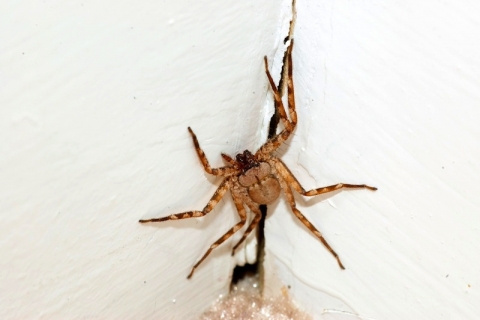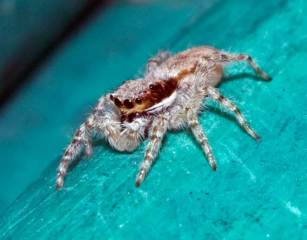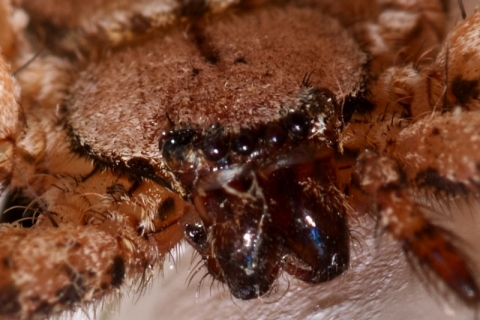I’ve written about Selenops spiders before, but thought I’d give it another go, now that there’s such a cooperative one living in a crack on the landing:
Most spiders build webs, so they rely more on their sense of touch to sense the vibrations of prey that have become stuck in their traps. Other groups of spiders, though, like the jumping spiders (Salticidae) and the wolf spiders (Lycosidae) have excellent vision, because they rely on it not only for safe and effective locomotion but to capture their meals.
As you might guess, web-building spiders have relatively small eyes, while jumping spiders and wolf spiders normally have at least one extra large pair among the eight eyes they typically carry. (For a comprehensive chart of spider eye arrangements, visit this page at bugguide.net.) Here’s a typical jumping-spider eye:
Notice how the eyes in the middle (the median eyes) are quite a bit larger than the next pair outboard, and there’s another pair that stare straight sideways mounted a bit higher up on the head. This arrangement enables the jumping spider (typified here by the pantropical Menemerus bivittatus, or Gray Wall Jumper) to execute their unparalleled feats of precise acrobatic locomotion.
The web-builders, on the other hand, generally have small, equal-sized eyes, like this friendly Eriophora ravilla I photographed last January:
Spiders in the family Selenopidae, on the other hand, lie somewhere between these two groups. They don’t build webs, but they hang out in crevices, between the glass and the mullion in your windowpane, and other such confined spaces, capturing prey by ambush. So their vision has to be pretty good, but they don’t need the extraordinary depth perception of the jumping spider.
And as you might expect, their eyes are somewhere in between the jumpers and the web-builders. They have four median eyes arranged in a semilunate arc (hence the allusion to the moon goddess, Selene, in their family and genus names), and two very large lateral eyes that presumably enable them to see quite well out the sides of their lair:
Combine that with the rather fearsome-looking jaws (called chelicerae by araneologists) and you have a beast that, while probably quite beneficial to the average homeowner, is usually considered to be less than endearing.




